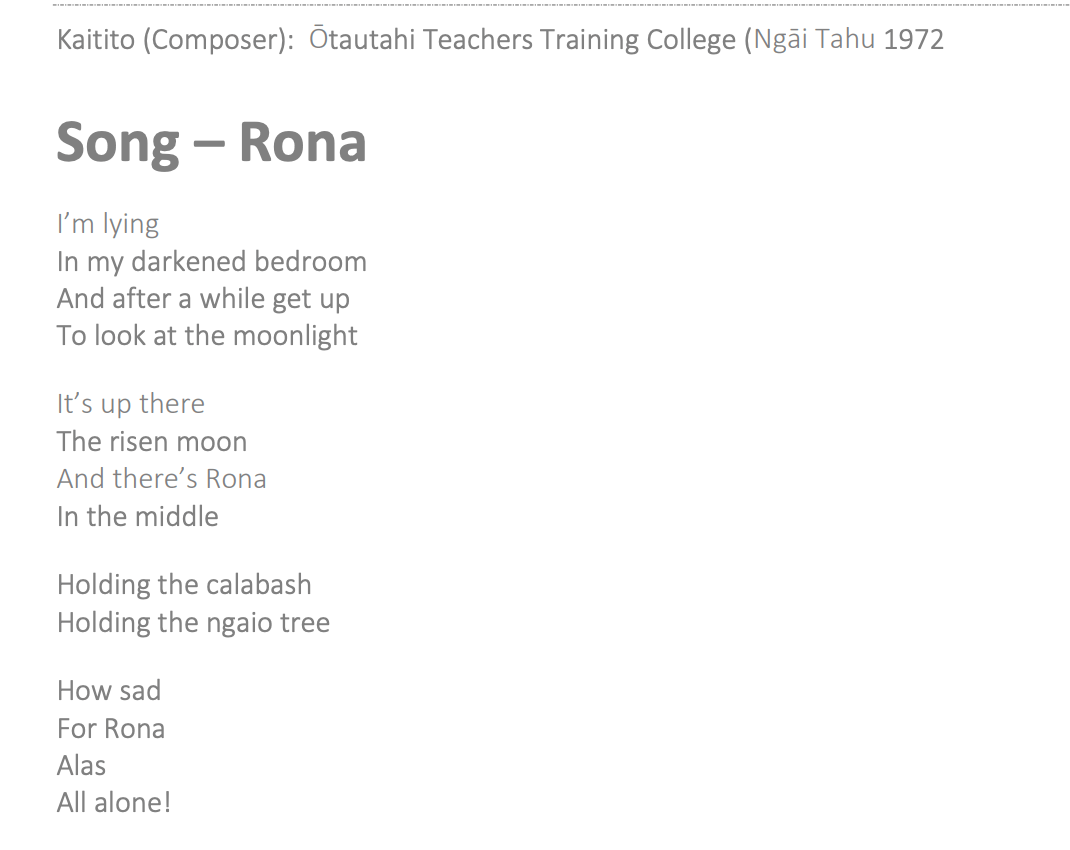RONA
Takoto ana au
Ki te moenga uriuri.
Tu ake au
Titiro ki te atarau.
Kei runga ra,
Te marama e whiti ana
Kei hea Rona
Kei roto ra.
Piri ki te taha,
Piri ki te ngaio.
Aue ra e Rona e, au…e, Rona e
ksss Hi Aue HI!!!!! (Boys)

KAITAKI TĀNE: Ki Raro!
Taringa whakarongo, kia mau!
ALL: HI !
KAITAKI TĀNE:
Ringaringa e torona kei waho hoki mai!
Kss Kss
KAITATAKI TIKA TONU!
ROPU: U – E
KAITATAKI TIKA TONU!
ROPU: U – E
TIKA TONU ATU KI A KOE, E TAMA
HIKI NEI KOE AKU WHAKAARO, PAKIA
E HIKI AHA TO HIKI?
E HIKI ROA TO HIKI?
I A HA HA!
E TAMA, TE UAUA ANA
E TAMA, TE MĀRŌ
ROA INA HOKI RA
TE TOHU O TE UAUA ANA
E TAU NEI!
ANA! ANA! ANA! AUE! HI!
TRANSLATION:
Pay attention
Listen up, take your stance!
Hi!
Arms outstretched,
out and back!
Kss Kss
What is right is always right!
In – deed!
What is right is always right!
Ah… yes!
Be true to yourself, my son!
You have raised my concerns, so listen up!…. .
What is this problem you are carrying?
How long have you been carrying it for?
Have you got that? Right, let’s go on.
So son, although it may be difficult for you
and son, although it seems to be unyielding
no matter how long you reflect on it
the answer to the problem
is here inside you.
Indeed! Indeed! Indeed! Yes, indeed!
Origin of this HAKA:
As far as is known, this haka was composed by Waimarama Puhara, a highly respected chief of the central Hawkes Bay area. Waimarama was born at Paki Paki in about 1875, the son of Urupene Puhara and Marata Herea, and he married Ngahiti Rautu in about 1900.
Apparently he composed the haka in about 1914 as a message to his son Moana, who had been born in about 1899 and had been attending St Patrick’s College, Silverstream. At the time Waimarama could see his son was having difficulties – something like a chip on his shoulder or some other intangible problem.
Moana married Ngawini Cowan (Kawana) at Gladstone, near Masterton in January 1922. But tragically, he died only five months later.
Usage
Young people are taught this haka as it contains an appropriate message for many adolescent males, particularly at that point in their lives where they are making the difficult transition into adulthood. The message of this haka is of challenge, struggle, perseverance and achievement. It is often used at events such as 21st birthdays and graduations. It is also used at tangi, to pay homage and respect to those who have guided young people through difficult times.
Tu Mai Ra – by Mike Kawana
1. Tini whetu ki te rangi
2. Ko Rangitāne ki te whenua
3. Ki ai he iwi hūmārie
4. Maranga, tū mai ra
5. Tū mai ra
6. Tū mai ra
7. Nga uri o Rangitāne
8. Whakamau
9. Ki tō tūpuna
10. Tō whakapapa rangātira
11.Me mau tōnu
12. ki ngā hononga
13. o ngā karanga maha
14. o roto rā
15. Nā reira Rangitāne ma
16. Tū mai ra
17. Tū mai ra e….
Like the myriads of stars in the sky
So are Rangitāne on the land
It is said a humble people they are
Rise up, Stand tall and proud
Stand tall and proud
Stand tall and proud
Descendants of Rangitāne
Hold fast
To your ancestral links
Your chiefly ranks
And those links
that tie you to
the many hāpu within
For that reason, Rangitāne people
Stand tall and proud
Stand tall and proud
